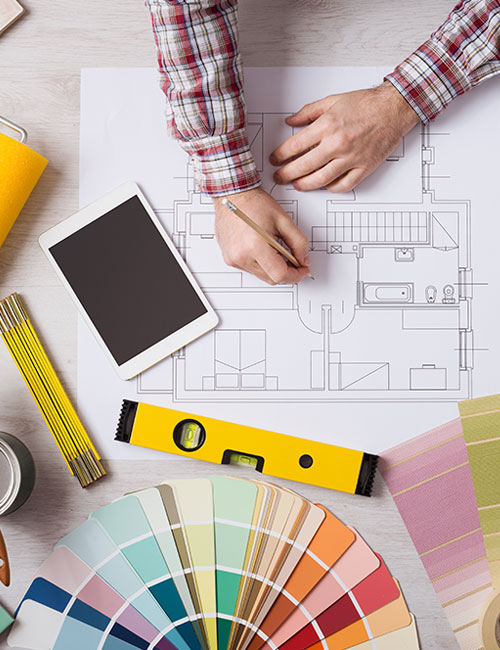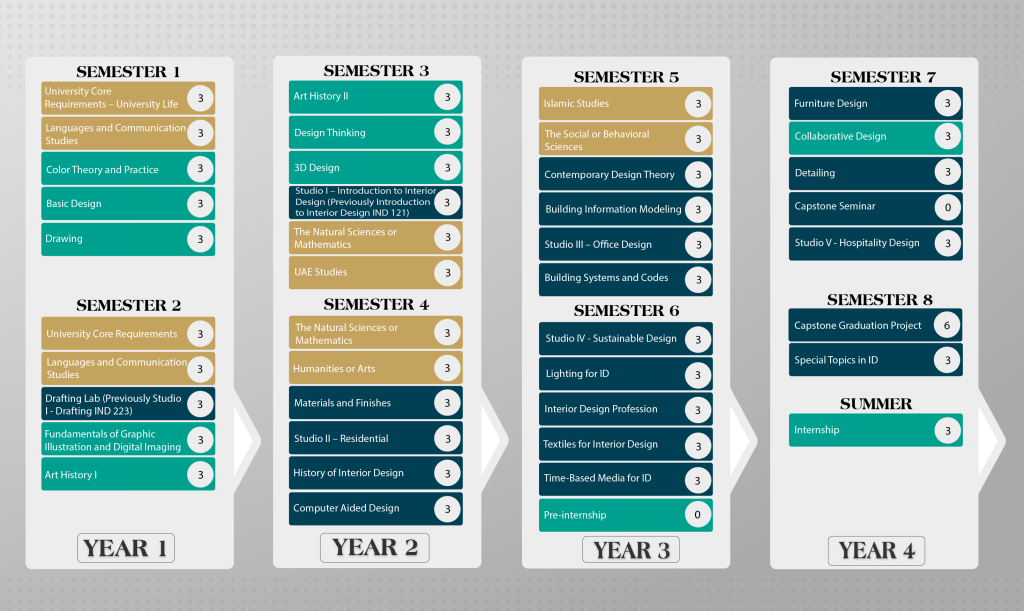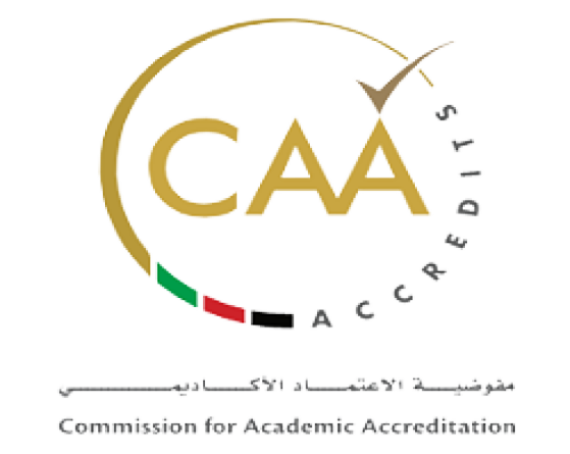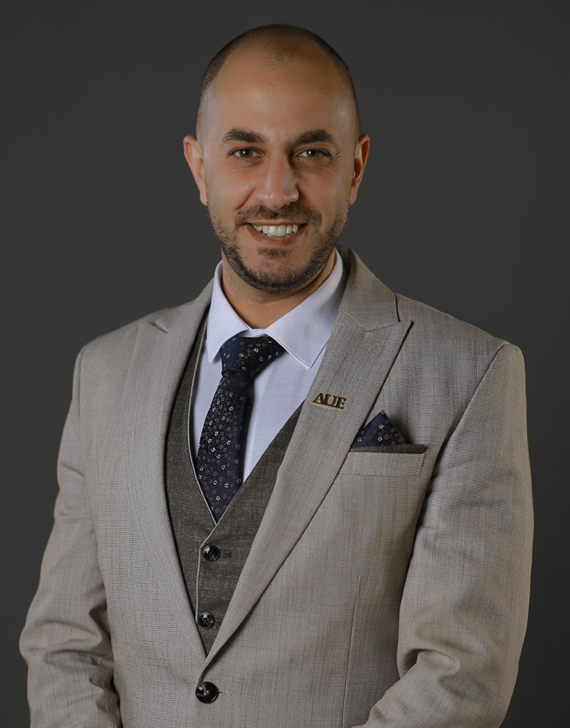Bachelor Of Science In Design - Interior Design

Create a Space for Everyone
The Interior Design program aims to teach students how to analyze design factors based on understanding the project objectives, goals and end user requirements. The course work includes design, analysis, construction and job administration. Students will be expected to conduct a wide range of research and on-site examination of areas selected for project work.
The primary objective of the interior design courses in the American University in the Emirates is to equip students with creative awareness, professional attitudes, imagination and technical knowledge required for this profession. Interior Design is a multifaceted profession in which creative and technical solutions are adopted within the building to maintain and achieve an interior environment through systematic design processes and techniques. The program objectives are as follows:
- Create a wide variety of interior designs for any project from concept stage to completion.
- Develop and implement designs through a variety of new and traditional design options.
- To become able to apply effective design techniques, principles and theories within one’s work.
- Learn and apply appropriate design tool and terminology.
- Use effective visual communication when completing projects and presentations.
The College has large design studios, state-of-the-art facilities provided with the latest electronic media and printing equipment and an extensive library filled with the latest tutorial educational resources relevant to interior design. They are all available for students to use in an engaged learning environment.
Students will be studying under the direction of experienced architects, engineers and tutors. Students will work towards projects in both commercial and residential interiors, developing a sense of how people function inside and outside these spaces. They will develop a range of live projects with themes including leisure and public interior spaces.
- Demonstrate breadth and depth of knowledge in interior design concepts, processes and practices.
- Use and integrate knowledge and relevant technologies, methodologies, and professional skills into meaningful interior design solutions.
- Apply critical thinking and analytical skills per industry standards.
- Produce a satisfactory body of interior design work, appropriate for a professional position in the industry.
- Appraise sustainable interior design practices in regional and global contexts.
ADMISSION
REQUIREMENTS
GRADUATION REQUIREMENTS
For undergraduate degree completion, undergraduate students must satisfy the following requirements:
- Earn a minimum CGPA of 2.00 on a scale of 4.00.
- Successfully complete all courses as described in the study plan.
- The Degree Completion requirements must be met within the timeframe of the program.
- Transfer students must successfully earn a minimum of 50% of the course credits for the program at AUE.
ACCREDITATION
PROGRAM STRUCTURE
Course Category
Total Number of Courses
Total Number of Credit Hours
General Education Courses
11
33
Core Courses
11
30
Specialization Courses
21
63
Total
43 Courses
126 Credit Hours
FEE STRUCTURE
Preparatory Courses
Prior to their enrollment in the program, students applying for Bachelor of Science in Design must sit for the placement test related to the program, failure to successfully passing the placement test, they are required to enroll in the following courses:
| # | Course Code | Course | Credit Hours | Exemption Condition |
| 1 | CIT 90 | Computer Preparatory | 0 | Passing the Placement Test |
| 2 | DES 90 | Drawing Preparatory | 0 | Passing the Placement Test |
| 3 | ENG 99 | Academic Writing (*) | 0 | Passing the Placement Test |
GENERAL EDUCATION COURSES
11 COURSES | 33 CREDIT HOURS
A: University Core Requirements
The student selects 6 credit hours (2 courses) from the list below:
B: Languages and Communication Studies
The student selects 9 credit hours (3 courses) from the list below:
Students must take all of the following courses:
This course provides students with advanced writing skills in English so that they can successfully pursue their studies in various academic specializations. It helps students to develop, improve, and upgrade their writing and structure skills, and it also acquaints students with technical writing, research papers, and essays since brief research methods are applied in student projects and assignments.
Students must take one of the following Arabic Language courses:
C: The Natural sciences or Mathematics
The student selects 6 credit hours (2 courses) from the list below:
D: The Social or Behavioral Sciences
The student selects 3 credit hours (1 course) from the list below:
E: The Humanities or Arts
The student selects 3 credit hours (1 course) from the list below:
F: Islamic Studies
The student selects 3 credit hours (1 course) from the list below
G: UAE Studies
The student selects 3 credit hours (1 course) from the list below
CORE COURSES
11 COURSES | 30 CREDIT HOURS
Pre-Internship is a zero credit hour internship preparatory course designed for students seeking an internship. The course will prepare students to successfully plan their internship by researching and identifying potential internship opportunities, creating professional resume and letter of introduction, developing interviewing and networking skills as well as a portfolio per industry requirements. Students will go through different learning modules including experiences, team work skills, communication skills, leadership skills, problem solving, self-management and professionalism to be able to make the most of their internship.
SPECIALIZATION COURSES
21COURSES | 63 CREDIT HOURS
This course introduces the materials and finishes used in the design of interior spaces and the basis of their prospective impact on the function and aesthetics of architectural interiors, the users’ wellbeing and safety and the environment at large. The students will explore the wide range of interior building materials, which will develop their prospects for creativity in design solutions. Technical vocabulary and systematic concepts associated with materials’ sourcing, manufacturing and evaluation will be stressed. Finally, the students will be aware of their role as interior and product designers in preserving natural resources and improving the quality of interior built environments for the users through studying examples of best practices.
The student is assigned to research and identify a topic, and develop a detailed research proposal highlighting the goals, objectives, tasks, methodology and time plan. The topic could range from an academic research to school/ community service, student-developed business or any other area of personal interest. The student communicates regularly with his/ her academic-capstone advisor for review, while working constantly to improve the outcome by building upon previously gained expertise. The academic-capstone advisor contributes through meaningful feedback and setting expectations of standards, offering an opportunity for open-ended learning through self-reflection and improvement.
The process is documented, findings are compiled and presented orally as well as in writing through a capstone report.
The project is divided into three distinct phases:
- Research and topic selection.
- Conceptual and design development.
- Design execution/ design presentation, with necessary documentation and a comprehensive report.
ATTENDANCE
Weekday Morning Classes
MON – WED | BETWEEN 9:00 AM – 4:00 PM
Weekday Evening Classes
MON – WED | BETWEEN 4:00 PM – 9:00 PM
WHEN CAN I JOIN
Student can join at the beginning of any semester
SEPTEMBER
FALL SEMESTER
MIN 3 COURSES | 9 CREDIT HOURS
MAX 6 COURSES | 18 CREDIT HOURS
JANUARY
SPRING SEMESTER
MIN 3 COURSES | 9 CREDIT HOURS
MAX 6 COURSES | 18 CREDIT HOURS
MAY
SUMMER SEMESTER
MIN 3 COURSES | 9 CREDIT HOURS
RECOMMENDED STUDY PLAN



